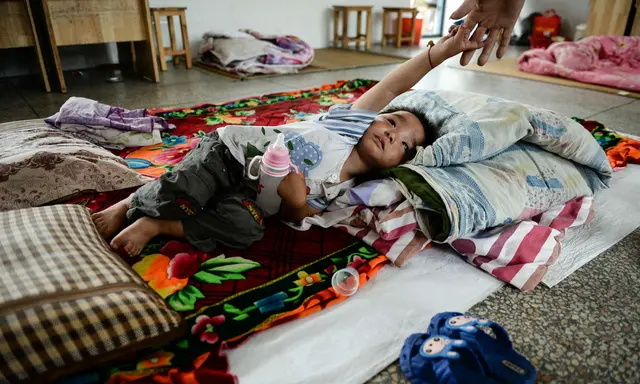Persistent torrential rain battering central and eastern China has paralysed Wuhan, in Hubei province, and is forecast to worsen.
A strong rainband that had left the region was being forced back by the developing Super Typhoon Nepartak east of Taiwan, the provincial weather forecaster said yesterday, warning that it could aggravate the week-long floods.
Premier Li Keqiang, who inspected neighbouring Hunan province earlier, arrived in Wuhan on Wednesday to assess conditions and relief efforts.
With the worst perhaps yet to come this month and next, the country must take precautions and prepare to keep residents safe, Li said.
Severe flooding outside Wuhan Railway Station on Wednesday, which has been caused by week-long torrential rain. Photo: SCMP
With parts of central and southwestern provinces deluged, President Xi Jinping, who also chairs the Central Military Commission, ordered the army and paramilitary police to step up disaster alleviation efforts, Xinhua reported. The nationwide death toll from the floods stood at 186 across 26 provinces.
Traffic is halted as flood levels rise in the centre of Wuhan on Wednesday. Photo: SCMP
Wuhan’s meteorological office said more than 570mm of rain had fallen since Thursday, breaking a record set in 1991 when 543mm fell over seven days, China News Service reported.
“It’s been raining for several days, but the urban areas of Wuhan only started flooding on Tuesday night, when the city was hit by continued heavy downpours,” Wuhan resident Tai Shan said. “It’s the suburban areas that have been hit hardest. I think the water level of the Yangtze is still two metres lower than its peak in 1998, so there is still nothing really to be feared,” he said as he watched the waters rise from the river’s bank in Wuchang district.
Flood water pours down an escalator in Wuhan on Wednesday. Photo: SCMP
Technology investor Zhu Bo said the floods had disrupted his business meetings, leaving him stranded at his hotel.
“I was supposed to meet about 20 start-up teams in Wuhan, with several of them travelling from Changsha,” Zhu said.
“So far none of them has been able to make it to the hotel.”
Flooding of the roads in Wuhan brings vehicles to a standstill on Wednesday. Photo: SCMP
The subway remains the only viable form of public transport in the city of 10 million although “waterfalls” had formed over the entrances to some stations.
Some companies, especially in suburbs hit by the worst flooding, were allowing employees to stay home. There were also brief blackouts and interruptions to water supplies in some areas.
The Hubei Department of Civil Affairs said more than 47 people had been killed and 10 others were missing as a result of the week of rain, which had affected about 11 million people in 17 cities and 80 counties across the province. More than 450,000 people had been evacuated.
A man rides a bicycle along a flooded street in Wuhan on Wednesday. Photo: Reuters
This year’s floods are reminiscent of the 1998 disaster that lasted from June until August, claiming more than 3,000 lives and affecting 220 million others across 24 provinces.
Compared with the 1998 disaster, this year’s rainfall has been much heavier but less concentrated. With the rain more evenly spread out over regions along the Yangtze River, the resulting flooding has been on a smaller scale.
The transport network in the city centre in Wuhan has been paralysed by the severe flooding. Photo: SCMP
The mainland has also built a great deal of water infrastructure over the past two decades. Some 17 billion yuan (HK$20 billion) in infrastructure was built between 1998 and 2002 to control floods from the river’s upper reaches.
Mainland experts say that despite this investment in flood-control measures, water management infrastructure and planning in cities had been slow to keep pace with the rapidly rising urban population.
Modern mass construction had created highly built-up areas that had altered natural water systems, which contributed to the risk of flooding, they said.
(SOUTH CHINA MORNING POST)
 简体中文
简体中文

